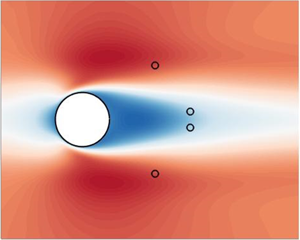Article contents
Linear and nonlinear sensor placement strategies for mean-flow reconstruction via data assimilation
Published online by Cambridge University Press: 21 July 2021
Abstract

Reynolds-averaged Navier–Stokes (RANS)-based data assimilation has proven to be essential in many data-driven approaches, including the augmentation of experimental data and the identification of turbulence model corrections. As dense measurements of the whole mean flow are not always available when performing data assimilation, we here investigate the case where only a few punctual mean velocity measurements are employed to infer the full mean flow. Sensor placement methodologies are developed targeting an enhancement in either (i) the extrapolation of the full mean velocity field from the few punctual measurements or (ii) the identification of the considered model correction, which is here a forcing term in the momentum equations that accounts for the divergence of the Reynolds stress tensor. Concerning the first objective, a sensor placement procedure based on the correct reconstruction of the dominant singular modes of the linearized RANS equations is developed. When focusing on retrieving the model correction, we propose in particular a second-order adjoint-based approach to improve the well posedness of the data assimilation problem. It consists in minimizing the condition number of the Hessian operator that is associated with the cost function to optimize in data assimilation. This procedure allows us to take into account all nonlinearities in the present inverse problem during the optimization of the sensor locations, thus ensuring its effectiveness. Numerical experiments on the reconstruction of the mean flow around a circular cylinder at  $Re=150$ confirm the validity of the developed sensor placement methodologies, which enable a significant improvement in the fidelity of the reconstructed flow with respect to the true one in multiple scenarios in terms of number of sensors and initial network arrangements.
$Re=150$ confirm the validity of the developed sensor placement methodologies, which enable a significant improvement in the fidelity of the reconstructed flow with respect to the true one in multiple scenarios in terms of number of sensors and initial network arrangements.
- Type
- JFM Papers
- Information
- Copyright
- © The Author(s), 2021. Published by Cambridge University Press
References
REFERENCES
- 18
- Cited by



